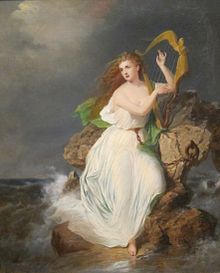Ériu

In Irish mythology, Ériu (Old Irish: [ˈeːrʲu]; modern Irish: Éire [ˈeːɾʲə] (![]() listen)), daughter of Delbáeth and Ernmas of the Tuatha Dé Danann, was the eponymous matron goddess of Ireland.
listen)), daughter of Delbáeth and Ernmas of the Tuatha Dé Danann, was the eponymous matron goddess of Ireland.
The English name for Ireland comes from the name Ériu and the Germanic (Old Norse or Old English) word land.
Since Ériu is represented as goddess of Ireland, she is often interpreted as a modern-day personification of Ireland, although since the name Ériu is the Old Irish form of the word Ireland, her modern name is often modified to Éire or Erin to suit a modern form.
Role and mythical portrayal[]
With her sisters, Banba and Fódla, she was part of a triumvirate of goddesses. When the Milesians arrived from Galicia, each of the three sisters asked that their name be given to the country. This was granted to them, although Ériu (Éire) became the chief name in use.[1] (Banba and Fódla are still sometimes used as poetic names for Ireland, much as Albion is used as a poetic name for Great Britain.)
Ériu was said to have been the wife of Mac Gréine, a grandson of Dagda.[1]
Ériu, Banba and Fódla are interpreted as goddesses of sovereignty.
According to the 17th-century Irish historian Geoffrey Keating (Seathrún Céitinn), the three sovereignty goddesses associated with Éire, Banbha and Fódla were Badb, Macha and The Morrígan.[2]
Different texts have attributed different personal relationships to Ériu. Her husband has been named as Mac Gréine (‘Son of the Sun’).[3] She has also been portrayed as the lover of Elatha, a prince of the Fomorians, with whom she had a son Bres, and as the mistress of the hero Lugh. Both Elatha and Ériu are described in some sources as the children of Delbaeth, indicating they may be half-siblings.[4] Her foster-father in the Rennes Dindsenchas was Codal the Roundbreasted, whose feeding Eriu caused the land in Ireland to heave toward the sky.[5]
Name and etymology[]
The University of Wales' reconstructed Proto-Celtic lexicon gives *Φīwerjon- (nominative singular Φīwerjō) as the Proto-Celtic etymology of this name.[6] This Celtic form implies Proto-Indo-European *piHwerjon-, likely related to the adjectival stem *piHwer- "fat" (cf. Sanskrit pīvan, f. pīvarī and by-form pīvara, "fat, full, abounding") hence meaning "fat land" or "land of abundance", applied at an early date to the island of Ireland. The Proto-Celtic form became *īweriū[7] in Q-Celtic (Proto-Goidelic). From a similar or somewhat later form were also borrowed Greek Ἰέρνη I[w]ernē and Ἰουερνία Iouernia; the latter form was converted into Latin Hibernia.
References[]
- ^ Jump up to: a b T. W. Rolleston (24 July 2012). Celtic Myths and Legends. New York: Dover Publications. p. 132. ISBN 9780486265070.
- ^ Geoffrey Keating. "The History of Ireland". Foras Feasa ar Éirinn – via UCC.ie.
- ^ Lebor Gabála Érenn. Online translation at www.ancienttexts.org
- ^ A D Rees, B R Rees (1961). "Celtic heritage : ancient tradition in Ireland and Wales". Thames and Hudson.CS1 maint: uses authors parameter (link)
- ^ Marie Henri d'Arbois de Jubainville (1870). Revue celtique. p. 109.
- ^ "Proto-Celtic—English lexicon" (PDF). Archived from the original (PDF) on 2006-01-14.
- ^ Mallory, J.P. and D.Q. Adams, ed. Encyclopedia of Indo-European Culture. London: Fitzroy Dearborn Pub., 1997, p. 194
Bibliography[]
- Boydell, Barra. "The female harp: The Irish harp in 18th- and early–19th-century Romantic nationalism", RIdIM/RCMI newsletter XX/1 (spring 1995), 10–17.
- Irish goddesses
- Tuatha Dé Danann
- Tutelary deities
- Personifications of Ireland
- National personifications
- Names for Ireland